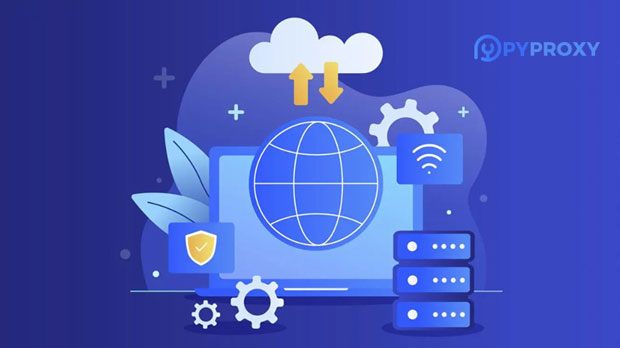In the context of networking, "by proxy" refers to the act of performing an action or service on behalf of another entity. It involves one system acting as an intermediary between two other systems, typically to route, filter, or manipulate data or requests. By proxy operations are commonly used in network management to enhance security, control, or performance. Understanding the "by proxy" operation at the network level requires a deep dive into concepts like proxy servers, routing, and data interception. This article aims to explore these aspects, providing both a theoretical and practical approach to how "by proxy" functions in modern network environments. Defining "By Proxy" in the Networking ContextA "by proxy" operation can be thought of as an intermediary action performed by a network device or service on behalf of another. In many networking scenarios, when one device or application cannot directly access or interact with another, a proxy is used to forward requests or responses. Essentially, this proxy acts as a gateway or middleman between the client and the server. The term "proxy" in networking refers to the system or server that performs these actions, and the phrase "by proxy" highlights that the operation is not being done directly by the requester but by an intermediary.Common examples of by proxy operations include web proxies, VPNs (Virtual Private Networks), and reverse proxies. In these cases, the user's request or data is routed through another server before reaching its final destination. This indirect interaction serves several purposes, including security, anonymity, load balancing, and access control.Types of "By Proxy" Operations1. Forward Proxy Servers A forward proxy is a server that sits between a client (such as a web browser) and the server (web server). It intercepts requests made by the client, modifying or redirecting them before they reach the final destination. This is often used to enforce policies, block unwanted content, or hide the client’s identity from the destination server. A forward proxy serves as an intermediary that communicates with the target server on behalf of the client.2. Reverse Proxy Servers A reverse proxy works the opposite way. Instead of representing the client, it represents the server. When a client sends a request to a server behind a reverse proxy, the proxy forwards the request to the appropriate backend server. This is often used in load balancing scenarios, where the reverse proxy distributes incoming requests to multiple servers to optimize performance and ensure high availability.3. Web Proxies Web proxies are used primarily for browsing the internet. They can be used to hide a user's IP address, bypass geographical restrictions, or access blocked content. Users connect to a proxy server, which then connects to websites on their behalf. This type of proxy is widely used for privacy and security.4. VPN (Virtual Private Network) A VPN is a special case of proxy, often used for secure communication over public networks. By creating a virtual tunnel between the user and the remote server, a VPN ensures that the user’s data is encrypted and routed through a proxy server. This secures the data against interception, while also masking the user’s original location.How "By Proxy" Operations Work at the Network LayerAt the network layer, "by proxy" operations are typically enabled through specialized devices or software that intercepts, forwards, or alters network traffic. These intermediary devices do not just pass data unchanged; they process the data in some way before sending it along to the destination. This could involve simple forwarding, encryption, or more complex transformations like filtering content or caching data for faster access.When a request is made, whether it’s a web request, database query, or file download, the intermediary proxy device captures the request and decides how to handle it. For example, a reverse proxy may first check if the requested content is cached. If it’s available, it serves it directly to the client, reducing the need for a backend server to handle the request. If the content is not cached, it forwards the request to the backend server and delivers the response once received.The Importance of "By Proxy" Operations in Network SecurityBy proxy operations are crucial in enhancing network security. One of the primary benefits is that they can act as a shield between the client and external networks, protecting sensitive information. Proxies can filter out harmful content, detect and block malicious traffic, and prevent direct exposure of internal systems to the public internet.For instance, in the case of a web proxy, it can block access to websites known to distribute malware, effectively preventing users from downloading harmful files. Similarly, reverse proxies can hide the internal structure of a network, making it more difficult for attackers to target specific systems.Performance Optimization through "By Proxy" OperationsIn addition to security, proxies also play a significant role in optimizing network performance. Proxy servers can cache frequently accessed content, reducing the load on backend servers and speeding up response times for users. This is especially beneficial in environments where users frequently request the same data, such as in the case of websites with high traffic.A reverse proxy, in particular, is often used for load balancing. By distributing incoming requests to multiple backend servers, a reverse proxy ensures that no single server becomes overwhelmed. This helps improve the scalability and reliability of the network, ensuring that performance remains high even during periods of heavy traffic.Practical Use Cases of "By Proxy" Operations1. Corporate Networks In corporate environments, proxies are commonly used to control and monitor employee internet usage. By routing all internet traffic through a proxy, the organization can enforce content filtering, track usage, and even restrict access to certain sites or services. This adds an additional layer of control, ensuring that employees adhere to company policies.2. Content Delivery Networks (CDNs) CDNs use reverse proxies to deliver content to users in the most efficient way possible. By placing servers in various geographic locations, CDNs can serve cached content from a location close to the user, reducing latency and improving load times. This system ensures that users experience faster and more reliable access to content.3. Privacy and Anonymity Many individuals use proxies or VPNs to protect their privacy while browsing the internet. By routing their requests through a proxy server, users can mask their IP addresses, making it more difficult for websites to track their online activities or identify their physical location. This is especially important in regions with strict internet censorship.Conclusion: The Value of "By Proxy" Operations in Networking"By proxy" operations play an essential role in modern networking, offering a wide array of benefits including enhanced security, improved performance, and privacy. From forward proxies that control access to web resources to reverse proxies that balance traffic across multiple servers, proxies are integral to managing network traffic efficiently. In corporate, security, and performance optimization contexts, the use of "by proxy" operations can make networks more secure, scalable, and reliable. Understanding these operations is crucial for anyone involved in network management or IT infrastructure design.
Jul 17, 2025
![arrow]()



















































